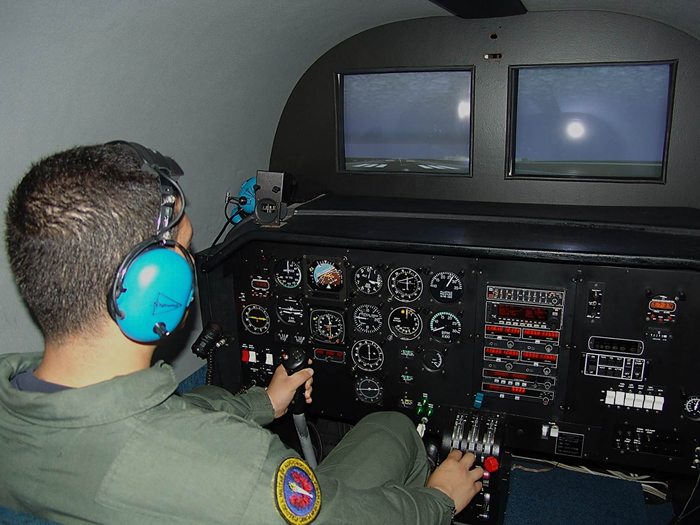Simulators for Training in the Colombian Air Force
DOI:
https://doi.org/10.18667/cienciaypoderaereo.142Keywords:
Emulation, Simulation, Simulation in the Colombian Air ForceAbstract
Simulation is a technique that involves software engineering, mechanical engineering and electrical engineering, as well emulation, which defines mathematical models to provide a machine with functional specifications for real-time operation of identical behavior to its counterpart to imitate. Moreover, to emulate is a duplication of the operations of something, trying to match them and even to exceed them. In this way, a machine is provided with simulation and emulation in real time, designing machines able to imitate and mimic others, without the risks, human or of infrastructure involved in reality, with the emulation according to the machine to equal. Training can be done on these machines, to provide and evaluate required skills to be developed in real life, in order to reduce costs and times implied. Thus, the objective of this article is to provide an insight into aviation simulators implemented in the Colombian Air Force.Downloads
References
Blackwood, R. (2011). El poder de la predicación y de la enseñanza.[En línea] Disponible en http://books.google.com.co/books?id=PLg8UN1BcH4C&printsec=frontcover&dq=El+poder+de+la+predicaci%C3%B3n+y+de+la+ense%C3%B1anza&hl=es&sa=X&ei=_Sh_VKCNLYmPyAS_s4HYBg&ved=0CBoQ6AEwAA#v=onepage&q=El%20poder%20de%20la%20predicaci%C3%B3n%20y%20de%20la%20ense%C3%B1anza&f=false.
Bolivar, S. (1828). Colección de documentos relativos a la vida pública del libertador de Colombia y del Peru Simon Bolivar. Caracas: Devisme.
Castillo, J. (2006). Administración de personal: un enfoque hacia la calidad. Bogotá: Ecoe ediciones LTDA
Castillo, S. (2002). Compromisos de la evaluación educativa. Madrid: Pearson Education.
Cañal de Leon, P. (2002). La innovación educativa. España: Akal S.A.
Centro de Investigación y Documentación Educativa-CIDE. (2003). La integración de las nuevas tecnologías en los centros. Una aproximación multivariada. Madrid: FER.
Coss Bu, R. (2008). Simulación un enfoque práctico. México: Limusa.
Chávez, G. (2003). Manual para el diseño de sistemas de calidad basado en competencias laborales. México: Panorama.
D'agostino de Cersósimo, G. (2007). Aspectos teóricos de la evaluación educacional. San José de Costa Rica: EUNED.
Department of Defense United States of America-DoD. (8 August, 2007). DoD Directive 5.000.59, Modeling and Simulation (M&S) Management. Arlington, Virginia: Department of Defense United States of America. In: http://www.dtic.mil/whs/directives/corres/pdf/500059p.pdf
Duvauchelle, M. (1994). Las fuerzas armadas y carabineros de Chile: su regulación constitucional y orgánica constitucional. Chile: Jurídica de Chile.
Escuela de Guerra. (2013). Centro de Simulación y Análisis de Crisis (CESAC). Bogotá: Escuela de Guerra.
Fernández de Soto, G. (2004). La ilusión posible: un testimonio sobre la política exterior colombiana. Bogotá: Norma.
Fernández, S. (2001). Análisis de efectividad en la evolución de programas sociales y educativos. Revista De educación.Infodefensa. (2012). Elbit Systems desarrolla un nuevo simulador de seguridad cibernética.Disponible en http://dialnet.unirioja.es/servlet/articulo?codigo=19380
Fuerzas Armadas de Colombia, FAC. (2005). Manual de Operaciones Aéreas (O- MAOPA).Bogotá: Imprenta de las Fuerzas Militares.
Fuerzas Armadas de Colombia, FAC. (2010). Plan estratégico institucional 2011-2030. Bogotá: Imprenta de las Fuerzas Militares.
Hidalgo, A. (2011). Israel, Siglo XXI Tradición y Vanguardia. La Coruña: Gesbiblo, S.L.
Infodefensa. (2012). Elbit Systems desarrolla un nuevo simulador de seguridad cibernética.
España: Autor. [En línea] Disponible en http://www.infodefensa.com/es/2012/06/05/noticia-elbit-systemsdesarrolla-unnuevo-simulador-de-seguridad-cibernetica.html.
Kirk, D. (2009). Words to Measure a War: Nine American Poets of World War II. North Carolina: McFarland & Company, Inc., Publishers.
Lipman, M. (2001). Pensamiento complejo y educación. Madrid: De la Torre.
Martín, E. (2008). Aprendizaje por simulación en la enseñanza deaviación. EE.UU: Createspace.
Monclus, J. (2010). La seguridad víal en las empresas. Programas internacionales de promoción. Madrid: Mafre.
Murcia, J. H. (2004). Redes del saber. Investigación virtual, Proceso educativo y autoformación integral. Bogotá: Cooperativa editorial Magisterio.
Pérez, M. (2001). Sistemas de interacción persona-computador. España: Servicio de impresiones de la Universidad Castilla de la mancha.
Platonov, V. N. (2001). La preparación física. Barcelona: Paidotribo
Ríos, D. (2000). Simulación Métodos y aplicaciones. Bogotá: Alfaomega.
Riley, R. H. (2008). Manual of simulation in healthcare. New York: Oxford.
Ross, S. M. (1997). Simulación. México: Prentice Hall
Senge, P. M. (2006). La quinta disciplina en la práctica. Buenos Aires: Ediciones Granica S.A
Siliceo, A. (2004). Capacitación y desarrollo de personal. México: Limusa.
Sperling, A. P. (2004). Psychology made simple. New York: Cía. General de ediciones S.A. de C.V.
Stark, J. (2010). Motion - is there a requirement in large fixed- wing aviation simulators? Canadian forces college JCSP 36. [En línea] Disponible en http://www.cfc.forces.gc.ca/259/290/296/286/Stark.pdf

Downloads
Issue
Section
License
Assignment of Copyrights
Authors assign Ciencia y Poder Aéreo journal the exclusive rights (reproduction, distribution, public communication, and transformation) to exploit and commercialize their work, in whole or in part, in all the formats and modalities of present or future exploitation, in all languages, throughout the life of the work and throughout the world.
All contents published in Ciencia y Poder Aéreo journal are licensed under a Creative Commons Attribution 4.0 International License, whose complete information is available at http://creativecommons.org/licenses/by/4.0/
Under the terms of this license, users are free to download, print, extract, archive, distribute and publicly communicate the content of articles, provided that proper credit is granted to authors and Ciencia y Poder Aéreo, scientific journal of the Graduate School of the Colombian Air Force. Except when otherwise indicated, this site and its contents are licensed under a Creative Commons Attribution 4.0 International License.
For other uses not considered under this license it is required to contact the Director or the Editor of the journal at the e-mail address cienciaypoderaereo1@gmail.com.
The Graduate School of the Colombian Air Force and this publication are not responsible for the concepts expressed in the articles, including the metadata or the affiliation stated by authors. This is the full responsibility of the authors.





















